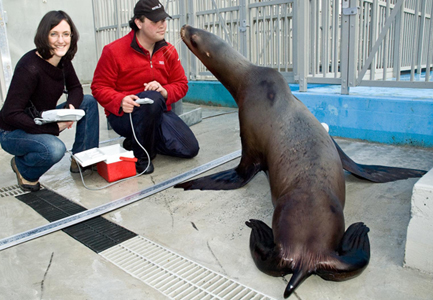
Does time of year affect recovery from nutritional stress?
Winter in the North Pacific Ocean is considered the most difficult time of year for Steller sea lions, largely due to the amount of energy they must spend foraging and keeping warm in rough winter seas. But the summer breeding season has its own unique metabolic demands on sea lions, and a critical change in food supply in either season could have dire consequences.
How do these seasonal environmental changes affect the health and dynamics of entire populations of Steller sea lions? With the assistance of trained animals housed at the Vancouver Aquarium, U.B.C. researchers Tiphaine Jeanniard du Dot, David Rosen, and Andrew Trites studied how sea lions respond physiologically to changes in quantity and type of food, and whether these responses differ between summer and winter.
 Studies have shown that a nutritionally stressed sea lion—experiencing a prolonged change in the quantity or quality of its diet—will lose different amounts of lipid (fats, oils, etc.) and protein tissues depending on the season and the quality of diet. Loss of lipid and protein can in turn affect the survival and reproduction of sea lions. Where most dietary studies concentrate on the period of nutritional restriction, the current study (published in the Journal of Experimental Marine Biology and Ecology) focused on how well the individual animals recovered after the stress had passed.
Studies have shown that a nutritionally stressed sea lion—experiencing a prolonged change in the quantity or quality of its diet—will lose different amounts of lipid (fats, oils, etc.) and protein tissues depending on the season and the quality of diet. Loss of lipid and protein can in turn affect the survival and reproduction of sea lions. Where most dietary studies concentrate on the period of nutritional restriction, the current study (published in the Journal of Experimental Marine Biology and Ecology) focused on how well the individual animals recovered after the stress had passed.
Seasonal Study
The experiment involved three 28-day phases and was conducted in the summer and repeated in the winter. Eight trained sea lions were separated into two groups and assigned different diets. The first group (Group H) ate varying quantities of Pacific herring throughout the experiment. The second group (Group P) ate herring in the first phase but switched to a restricted diet of less-nutritious walleye pollock for the second phase, and then resumed eating regular quantities of nutritious herring during the final phase. Although they ate different fish, both groups were assigned restricted diets during the second phase.
Researcher and trainer prepare to measure blubber thickness of the Steller sea lion using an ultrasound machine.

Researcher and trainer prepare to measure blubber thickness of the Steller sea lion using an ultrasound machine.
The researchers found that in both summer and winter, Group H lost significantly more lipids and less lean mass (protein) than Group P, which was fed pollock during the restricted phase. The response of Group H was consistent with the predicted pattern of nutritional stress, in which sea lions use up their lipid reserves in order to preserve protein tissue. The researchers were surprised to note that Group P lost a high proportion of protein while consuming restricted levels of pollock – which could lead to muscle impairment and vital organ failure in the long term. Each of the sea lions increased their rates of mass gain and returned to their pre-experimental weight during winter, but not during summer.
“Critical” Summer Period
“Nutritional stress has been commonly assumed to be more strenuous during winter than summer,” the authors write. “However, our results showed not only that sea lions withstand periods of mild nutritional stress more easily in winter, but they also are able to recover more easily from it in winter compared to the summer.”
Measuring blubber thickness while Willo rests with her head inside a plastic head guard.
Indeed, the sea lions appeared to need a large increase in energy intake in summer to recover from any loss of body mass. Without this dietary boost, the researchers note, a wild sea lion would risk remaining in a suboptimal state throughout the summer that would ultimately decrease its ability to breed. Consequently, the authors maintain, summer may be a more critical period than winter for a sea lion recovering from mild nutritional stress because of evolutionary processes that shaped the sea lion’s physiology to contend with uncertainty and predictability in environmental conditions. Prey species tend to have higher energy content during summer and occur in more predictable conditions compared to winter. As such, sea lions may be physiologically pre-adapted to better contend with food shortages in winter than in summer.
The study contributes significantly to the overall understanding of the consequences of nutritional stress on Steller sea lions, and provides new insights into the seasonal effects of a diet of low-energy fish. However, the reasons behind the seasonal difference in the capacity of sea lions to recover from nutritional stress remain unclear, leaving the door open for further investigation.
PUBLICATION
|

|

 |
||||||||||||
